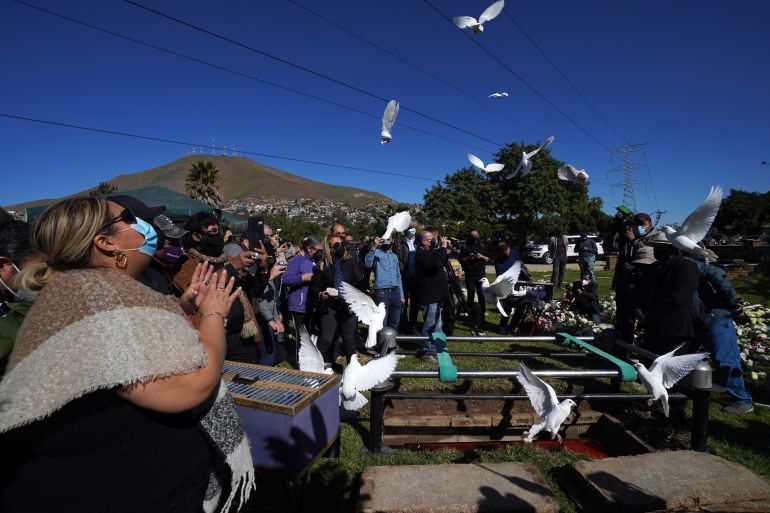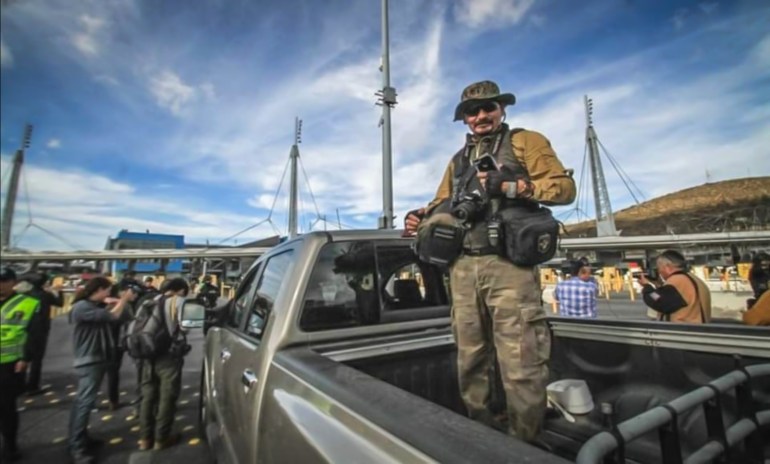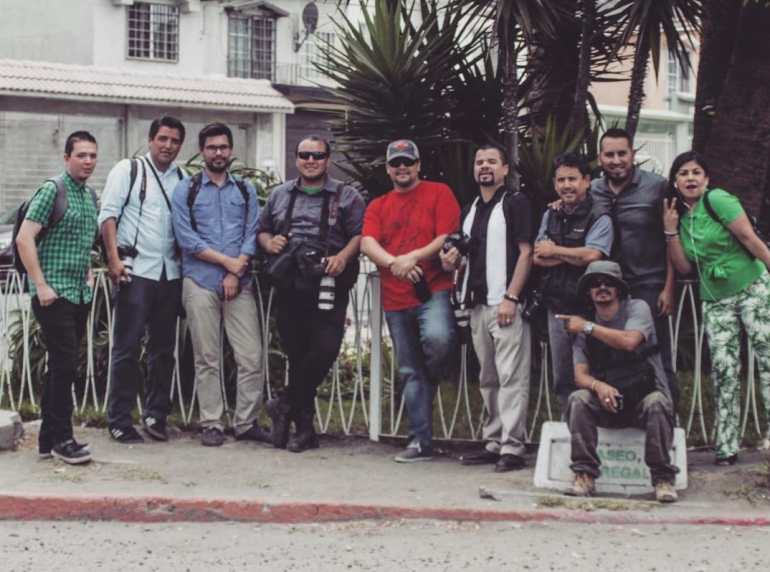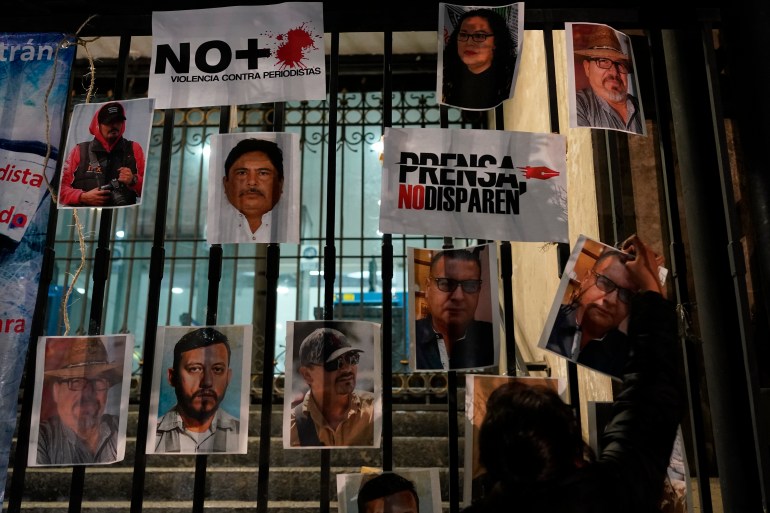What’s behind the spike in journalist murders in Mexico?
Four journalists were killed in January, highlighting a dangerous culture of impunity in the country, rights groups say.

Los Angeles, California – Against a backdrop of increasing violence, human rights violations and impunity in Mexico, attacks against journalists are spiking, with four killed last month alone.
On January 31, three armed men reportedly shot Robert Toledo, a videographer for Monitor Michoacan, as he prepared to film an interview west of Mexico City.
Keep reading
list of 3 items‘Remain in Mexico 2.0’: How did the Trump-era policy get revived?
In Pictures: The Indigenous town in Mexico living on remittances
Days earlier, reporter Lourdes Maldonado Lopez was shot dead in Tijuana – the same city where freelance photographer Margarito Martinez, who documented crime scenes, was fatally shot on January 17.
And earlier last month, Jose Luis Gamboa Arenas, director of the news site Inforegio in Veracruz, a notoriously violent and corrupt region, died from stab wounds.
Two more journalists in Mexico had close calls in January: One reporter was shot at and escaped, and another was wounded in a knife attack, according to Jan-Albert Hootsen, the Mexico representative for the Committee to Protect Journalists.

“We’ve seen what’s very likely the most violent month in terms of violence against journalists in a decade,” Hootsen told Al Jazeera.
And media freedom groups warn the violence shows no sign of abating: “Every year, it’s getting worse and worse,” Paula Maria Saucedo Ruiz of Article 19, a group that defends freedom of expression, told Al Jazeera.
No consequences
While there is little data on the history of violence against journalists before the 1980s, Hootsen said, the current trend can be traced back to 2006, when the Mexican government declared war on organised crime and deployed the military. This led to an explosion in violence across the country, including against journalists who dared to report on the conflict.
With organised criminal groups fighting each other and the Mexican state, the country’s justice system has eroded, while corruption has proliferated at the local and state levels, resulting in near-total impunity.
About 99 percent of crimes against journalists are not prosecuted, Ruiz said, “Anyone can decide, ‘I’m just going to silence this journalist, because there are not going to be consequences.’”
Hootsen visited Tijuana last week after Martinez and Lopez were killed. He called the city “the murder capital of Mexico”, as it now averages about five homicides a day.
According to a GoFundMe set up by Martinez’s colleagues on behalf of his wife and teenage daughter, he knew the risks, but still continued to cover the rising violence in the border city.

Criminal groups are at war across Tijuana, willing to go to extreme lengths to defend their interests, while the local government is unwilling or unable to act, Hootsen said: “It creates an extremely dangerous, toxic environment for journalists to work.”
Manuel Ayala, a freelance journalist who covers missing persons, human trafficking, migration and organised crime in Tijuana, says he is careful who he talks to, as sources can also be informants for criminal organisations. After publishing, he keeps a low profile.
While no one has directly threatened him on the job, Ayala has heard warnings. In one case, a local police patrol recorded his personal information and told him to stay away from a certain area, he said; another time, a source suggested he stop investigating a trafficking story.
“Our bosses do not protect us. We protect ourselves,” Ayala told Al Jazeera in Spanish over WhatsApp, noting that Tijuana journalists are in constant communication about where they are going and whether there’s a risk.
In this tight-knit community, Ayala and Martinez were friends: “Since I arrived in Tijuana, he always welcomed me. I saw him as an older brother, because he used to guide me on the dynamics of the city, on how to make things easier for me when doing my job. Margarito used to do that a lot with everyone.”
Security ‘woefully insufficient’
About 500 journalists are enrolled in a federal mechanism to protect journalists, with protections ranging from home surveillance systems to bodyguards. Similar programmes exist in some states, but members of the media are highly sceptical of their efficacy.
Of the four journalists killed in January, only Lopez was enrolled for protection, Hootsen said.
“The security she received from the Baja California authorities was woefully insufficient,” he said.
While Martinez was in the process of being enrolled in the federal scheme, at the time of his death he had no protection, Hootsen added.
Days before she was killed, Lopez called out state corruption, dedicated her broadcast to Martinez, and said she was under state protection.
“They take good care of you, but no one can avoid – not even under police supervision – getting killed outside your house in a cowardly manner,” she said, according to a report from the AP news agency.
Ayala, who is not enrolled in a protection mechanism, said journalists do not trust the state apparatus, “There are many flaws and it needs to be improved.”
Such systems are reactive instead of preventive, Ruiz said, noting that in order to get protection, a journalist must have experienced a direct threat or attack.
The mechanisms are also under-resourced, she added.
While Mexican President Andres Manuel Lopez Obrador regularly berates journalists, he told a news conference after Lopez’s killing, “We are obliged to investigate this crime and prevent the murders of journalists and citizens from continuing.”
Yet, despite coming to power on promises of peace, Obrador has shown no inclination towards solving the problem, Hootsen said, while Mexican states have “an almost unreal indifference” to the plight of their own citizens.

While it is hard to find hope, Ruiz and Hootsen say they are encouraged by the solidarity among Mexican journalists, who held demonstrations across 65 cities in response to the deaths of their colleagues.
Ruiz also pointed to groups of reporters collaborating across borders to reveal corruption in Mexico. By co-publishing, local journalists face less risk of being singled out.
Every significant change in human rights in Mexico is a direct result of activists, academics and journalists speaking out and placing pressure on authorities, Hootsen said, “That’s where I get my optimism from.”